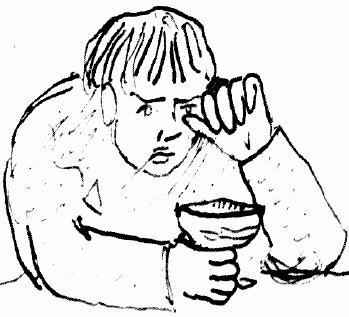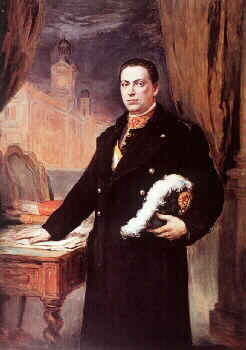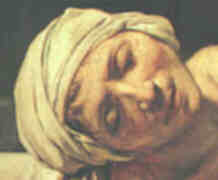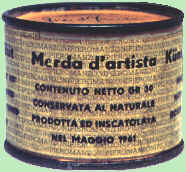1941 Britain and the Soviet Union sign a mutual aid pact, providing
the means for Britain to send war materiel to the Soviet Union.
1938 Television theater opens. 200 people pay 25 cents each to
see a television show aired at the Massachusetts Television Institute,
the first television theater. The theater broadcasts a variety show of
music and dance numbers from a room in the theater to an auditorium fitted
with a 23-by-31-cm black-and-white television screen. (cf. 1930 below)
1936 44ºC, Mio, Michigan (state record)
1936 46ºC, Wisconsin Dells, Wisc. (state record)
1931 A major German financial institution, Danabank, fails, leading
to the closing of all banks in Germany until 05 August. By the end
of the 1931, approximately six million Germans are out of work.
1931 Dinamarca presenta una acusación ante el Tribunal Internacional
de La Haya y solicita la reunión de la Sociedad de Naciones por la ocupación
noruega del este de Groenlandia.
1930 Sarnoff reports in NY Times "TV will be a theater
in every home" (cf. 1938 above)
1919 Race riots in Longview & Gregg counties Texas
1918 El Reichstag acuerda otro empréstito de guerra por un valor
de doce mil millones de marcos.
1917 In Fátima, Portugal, as on the 13th of every month
from May to October 1917 (except in August, when it was on the 19th),
three young peasant children, Lucia dos Santos, 10, and her cousins Francisco
and Jacinta Marto, report seeing a lady who identifies herself as the
Lady of the Rosary.
| 1914 Monday : in the aftermath of the June
28 assassination of Archduke Francis Ferdinand:
Wiesner wires his findings back to Berchtold: Nothing has
been found to implicate the Serbian government in the assassination.
Berchtold keeps the findings away from Franz Josef.
Krobatin leaves for vacation in Bad Gastein as planned.
|
1910 Todos los tripulantes dl dirigible alemán Erbsloehe
que estalla a gran altura sobre Colonia.
1878 Treaty of Berlin amended terms of Treaty of San Stefano,
divides the Balkans among European powers. The Treaty of Berlin amended
the terms of the Treaty of San Stefano, which had ended the Russo-Turkish
War of 1877-78.
 1873
Verlaine blesse Rimbaud
^top^ 1873
Verlaine blesse Rimbaud
^top^
En septembre 1871, Arthur débarque
à Paris, invité par Verlaine à qui il a envoyé ses poèmes. Verlaine,
de 10 ans plus âgé que lui, est fasciné et tombe sous le charme.
Rimbaud, lui, voit en Verlaine un compagnon capable de le suivre
dans sa quête de Voyant, et considère son homosexualité comme
une étape de son expérience de la connaissance universelle.
Hélas ! Paul est un être soumis, tiraillé entre l'amour qu'il
éprouve pour sa femme Mathilde et sa passion pour Rimbaud. Ils
vivront moins de deux ans ensemble, vie commune qui s'achèvera
par un drame : le
10 [????] juillet 1873 à Bruxelles, Verlaine, ivre et déchiré,
blesse Rimbaud d'un coup de pistolet car son jeune amant a décidé
de le quitter. Arthur s'enfuiera en Europe puis en Afrique et
effacera son existence passée dont il parlera une fois comme
de "souillures". Verlaine, lui, ne l'oubliera jamais, et contribuera
à la postérité de l'oeuvre de son ancien amant... [< Rimbaud
par Verlaine, dans une lettre à Delahaye, 1875]
Arthur Rimbaud, amant de Paul Verlaine,
gagne Bruxelle pour le rejoindre après une nouvelle dispute.Mais
si les retrouvailles sont chaleureuses, une nouvelle dispute
naît entre eux, probablement au cours d’une de leurs beuveries
habituelles. Verlaine furieux, tire un coup de révolver contre
Rimbaud. La police belge, moins tolérante que la Française pour
les frasques des deux génies littéraires, arrête Verlaine et
le condamne à plusieurs mois de prison. Rimbaud se remettra
vite de cette blessure et se retire à Roche pour achever un
de ses chefs d’œuvre, immortel : Une
Saison en Enfer un "carnet de damné", qui sera d’ailleurs
publié dans la clandestinité, à Bruxelles, chez Poot et Cie,
spécialiste des éditions "judiciaires".
autres RIMBAUD ONLINE: Illumination
— Oeuvres
— Poésies
complètes (préface de Verlaine) — Poésies:
Ophélia |
1870 La Prusse provoque la guerre
de 70-71: “le gant d'Ems”
^top^
On vient de jeter un gant à la
face de quelqu'un qu'on veut forcer à se battre ", déclare Adolphe
Thiers au corps législatif. La gant jeté est une dépêche.
Lors de sa rencontre avec l'ambassadeur de France Benedetti,
Guillaume Ier, roi de Prusse, fait une réponse que Bismarck
rapporte de telle sorte qu'elle devient injurieuse pour la France.
En effet, Bismarck voudrait que la France déclare la guerre
pour faire jouer le traité d'alliance défensive des Etats de
la Confédération germanique. Il obtient ce qu'il veut. Le journal
Le Constitutionnel écrit : "A l'insolence de la Prusse,
il n'y a qu'une réponse: la guerre " |
1868 Oscar J Dunn, former slave, installed as lt governor of
Louisiana
1866 Great Eastern begins a two week voyage to complete
a 12-year effort to lay telegraph cable across the Atlantic between Britain
and the United States.
1866
Construction begins on Fort Phil Kearny
^top^
Colonel Henry Carrington begins
construction on Fort Phil Kearny, the most important army outpost
guarding the Bozeman Trail. In 1863, a Georgia-born frontiersman
named John Bozeman blazed a wagon road that branched off from
the Oregon Trail and headed northwest to the gold fields of
western Montana. The trail passed through the traditional hunting
grounds of the Sioux, and Chief Red Cloud attacked several wagon
trains to try to stop the violation of Indian Territory. Despite
the questionable legality of the Bozeman Trail, the US government
decided to keep it open and began building a series of protective
army forts along the route. Colonel Henry Carrington was assigned
the task of designing and building the largest and most important
of these outposts, Fort Phil Kearny. A talented strategist and
designer, Carrington planned the fort with care. He selected
a site in northern Wyoming that was near a source of water and
commanded a view over a good section of the Bozeman Trail.
He began building on this day
in 1866, setting up a timbering operation and sawmill to supply
the thousands of logs needed for construction. By fall, Carrington
had erected an imposing symbol of American military power. A
tall wooden palisade surrounded a compound the size of three
football fields. Inside the walls, Carrington built nearly 30
buildings, including everything from barracks and mess halls
to a stage for the regimental band. Only the most massive and
determined Indian attack would have been capable of taking Fort
Phil Kearny. Unfortunately, Carrington's mighty fortress had
one important flaw: the nearest stands of timber lay several
miles away. To obtain the wood essential for heating and further
construction, a detachment had to leave the confines of the
fort every day. The Indians naturally began to prey on these
"wood trains." In December, a massive Indian ambush wiped out
a force of 80 soldiers under the command of Captain William
Fetterman. Despite this weakness, Fort Phil Kearny was still
a highly effective garrison. Nonetheless, the US Army found
it nearly impossible to halt completely the Indian attacks along
the trail. In 1868, the government agreed to abandon all of
the forts and close the trail in exchange for peace with the
Indians. Immediately after the soldiers left, the Indians burned
Carrington's mighty fortress to the ground. |
1865 Horace Greeley, 54, advises his readers (New York Tribune)
to "Go west young man"
1863 Engagement at Bayou La Fourche, Louisiana
1863 Siege of Fort Wagner, Charleston Harbor, South Carolina continues
1862 Garrison at Murfreesboro, Tennessee captured by Confederate
General Nathan Bedford Forrest
1861 Skirmish at Corrick's Ford, Virginia (now West Virginia)
1858 Entrevue Napoléon — Cavour. Au cours de l'une de ses
cures à Plombières, Napoléon rencontre Cavour. Le tête-à-tête secret
dure sept heures. Le ministre du roi Victor-Emmanuel, qui aspire à faire
de l'Italie un seul Etat, convainc l'empereur. Napoléon aidera l'Italie
à faire son unité, mais à la seule condition que l'Autriche soit l'agresseur.
Ce fut fait
1854 US forces shell & burn San Juan del Norte, Nicaragua
1841 Austria, Inglaterra, Prusia, Rusia y Francia firman en Londres
la Convención de los estrechos, acuerdo con Turquía para cerrar
el Bósforo a los buques de guerra extranjeros.
1832 Henry R. Schoolcraft discovers the source of the Mississippi
River in Minnesota.
1798
Wordsworth visits Tintern Abbey
^top^
While on a walking tour, William
Wordsworth, 28, and his sister Dorothy visit a ruined church
called Tintern Abbey. The ruins inspired Wordsworth's poem Tintern
Abbey, in which Wordsworth articulated some of the fundamental
themes of Romantic poetry, including the restorative power of
nature. The poem appeared in Lyrical
Ballads, with a Few Other Poems in 1798, which Wordsworth
collaborated on with his friend and fellow poet Samuel Taylor
Coleridge. The book, which also included Coleridge's Rime
of the Ancient Mariner, sold out within two years. The book's
second edition included an important preface that articulated
the Romantic manifesto.
Wordsworth was born near England's
Lake District on 7 April 1770. He lost his mother when he was
eight, and his father died five years later. Wordsworth attended
Cambridge, then traveled in Europe, taking long walking tours
with friends through the mountains. During his 20s, Wordsworth
lived with his sister Dorothy and became close friends with
Coleridge. In 1802, after years of living on a modest income,
Wordsworth came into a long-delayed inheritance from his father
and was able to live comfortably with his sister. He married
their longtime neighbor Mary Hutchinson and had five children.
The poet's stature grew steadily, although most of his major
work was written by 1807. In 1843, he was named poet laureate
of England, and he died on 23 April 1850, at the age of 80.
Works online:
The Complete
Poetical Works (HTML at Bartleby)
Lyrical
Ballads (multiple versions of the first edition, with
commentary), also by Coleridge (HTML, SGML, and page images
at dal.ca)
WRITTEN A FEW MILES ABOVE TINTERN
ABBEY, ON REVISITING THE BANKS OF
THE WYE DURING
A TOUR, July 13, 1798.
|
|
Five years have passed; five summers, with the length
Of five long winters! and again I hear
These waters, rolling from their mountain-springs
With a sweet inland murmur. — Once again
Do I behold these steep and lofty cliffs,
Which on a wild secluded scene impress
Thoughts of more deep seclusion; and connect
The landscape with the quiet of the sky.
The day is come when I again repose
Here, under this dark sycamore, and view
These plots of cottage-ground, these orchard-tufts,
Which, at this season, with their unripe fruits,
Among the woods and copses lose themselves,
Nor, with their green and simple hue, disturb
The wild green landscape. Once again I see
These hedge-rows, hardly hedge-rows, little lines
Of sportive wood run wild; these pastoral farms
Green to the very door; and wreathes of smoke
Sent up, in silence, from among the trees,
With some uncertain notice, as might seem,
Of vagrant dwellers in the houseless woods,
Or of some hermit's cave, where by his fire
The hermit sits alone.
Though absent long,
These forms of beauty have not been to me,
As is a landscape to a blind man's eye:
But oft, in lonely rooms, and mid the din
Of towns and cities, I have owed to them,
In hours of weariness, sensations sweet,
Felt in the blood, and felt along the heart,
And passing even into my purer mind
With tranquil restoration: — feelings too
Of unremembered pleasure; such, perhaps,
As may have had no trivial influence
On that best portion of a good man's life;
His little, nameless, unremembered acts
Of kindness and of love. Nor less, I trust,
To them I may have owed another gift,
Of aspect more sublime; that blessed mood,
In which the burthen of the mystery,
In which the heavy and the weary weight
Of all this unintelligible world
Is lighten'd — that serene and blessed mood,
In which the affections gently lead us on,
Until, the breath of this corporeal frame,
And even the motion of our human blood
Almost suspended, we are laid asleep
In body, and become a living soul:
While with an eye made quiet by the power
Of harmony, and the deep power of joy,
We see into the life of things.
If this
Be but a vain belief, yet, oh! how oft,
In darkness, and amid the many shapes
Of joyless day-light; when the fretful stir
Unprofitable, and the fever of the world,
Have hung upon the beatings of my heart,
How oft, in spirit, have I turned to thee
O sylvan Wye! Thou wanderer through the wood
How often has my spirit turned to thee!
And now, with gleams of half-extinguished though[t,]
With many recognitions dim and faint,
And somewhat of a sad perplexity,
The picture of the mind revives again:
While here I stand, not only with the sense
Of present pleasure, but with pleasing thoughts
That in this moment there is life and food
For future years. And so I dare to hope
Though changed, no doubt, from what I was, when first
I came among these hills; when like a roe
I bounded o'er the mountains, by the sides
Of the deep rivers, and the lonely streams,
Wherever nature led; more like a man
Flying from something that he dreads, than one
Who sought the thing he loved. For nature then
(The coarser pleasures of my boyish days,
And their glad animal movements all gone by,)
To me was all in all. — I cannot paint
What then I was. The sounding cataract
Haunted me like a passion: the tall rock,
The mountain, and the deep and gloomy wood,
|
Their colours and their forms, were then to me
An appetite: a feeling and a love,
That had no need of a remoter charm,
By thought supplied, or any interest
Unborrowed from the eye. — That time is past,
And all its aching joys are now no more,
And all its dizzy raptures. Not for this
Faint I, nor mourn nor murmur: other gifts
Have followed, for such loss, I would believe,
Abundant recompence. For I have learned
To look on nature, not as in the hour
Of thoughtless youth, but hearing oftentimes
The still, sad music of humanity,
Not harsh or grating, though of ample power
To chasten and subdue. And I have felt
A presence that disturbs me with the joy
Of elevated thoughts; a sense sublime
Of something far more deeply interfused,
Whose dwelling is the light of setting suns,
And the round ocean, and the living air,
And the blue sky, and in the mind of man,
A motion and a spirit, that impels
All thinking things, all objects of all thought,
And rolls through all things. Therefore am I still
A lover of the meadows and the woods,
And mountains; and of all that we behold
From this green earth; of all the mighty world
Of eye and ear, both what they half-create,
And what perceive; well pleased to recognize
In nature and the language of the sense,
The anchor of my purest thoughts, the nurse,
The guide, the guardian of my heart, and soul
Of all my moral being.
Nor, perchance,
If I were not thus taught, should I the more
Suffer my genial spirits to decay:
For thou art with me, here, upon the banks
Of this fair river; thou, my dearest Friend,
My dear, dear Friend, and in thy voice I catch
The language of my former heart, and read
My former pleasures in the shooting lights
Of thy wild eyes. Oh! yet a little while
May I behold in thee what I was once,
My dear, dear Sister! And this prayer I make,
Knowing that Nature never did betray
The heart that loved her; 'tis her privilege,
Through all the years of this our life, to lead
From joy to joy: for she can so inform
The mind that is within us, so impress
With quietness and beauty, and so feed
With lofty thoughts, that neither evil tongues,
Rash judgments, nor the sneers of selfish men,
Nor greetings where no kindness is, nor all
The dreary intercourse of daily life,
Shall e'er prevail against us, or disturb
Our chearful faith that all which we behold
Is full of blessings. Therefore let the moon
Shine on thee in thy solitary walk;
And let the misty mountain winds be free
To blow against thee: and in after years,
When these wild ecstasies shall be matured
Into a sober pleasure, when thy mind
Shall be a mansion for all lovely forms,
Thy memory be as a dwelling-place
For all sweet sounds and harmonies; Oh! then,
If solitude, or fear, or pain, or grief,
Should be thy portion, with what healing thoughts
Of tender joy wilt thou remember me,
And these my exhortations! Nor, perchance,
If I should be, where I no more can hear
Thy voice, nor catch from thy wild eyes these gleams
Of past existence, wilt thou then forget
That on the banks of this delightful stream
We stood together; And that I, so long
A worshipper of Nature, hither came,
Unwearied in that service: rather say
With warmer love, oh! with far deeper zeal
Of holier love. Now wilt thou then forget,
That after many wanderings, many years
Of absence, these steep woods and lofty cliffs,
And this green pastoral landscape, were to me
More dear, both for themselves, and for thy sake.
|
1789 Constitution de la Garde Nationale, une armée de 48'000 hommes
destinée à protéger Paris et à assurer le maintien de l’ordre. Son premier
général sera le marquis de Lafayette, le héros français de l’Indépendance
Américaine.
1787 US Congress, under the Articles of Confederation, enacts
the Northwest Ordinance, establishing rules for governing the Northwest
Territory (excludes slavery), for admitting new states to the Union and
limiting the expansion of slavery. A territory can become 3 to 5 states
at 60'000 population
1760 Carlos III entra solemnemente en Madrid como rey de España
para suceder a su hermanastro Fernando VI.
1754 At the beginning of the French and Indian War, George Washington
surrenders the small, circular Fort Necessity in southwestern Pennsylvania
to the French, leaving them in control of the Ohio Valley.
1713 La firma del Tratado de Utrecht pone fin definitivamente
a la Guerra de Sucesión Española.
1648 A la suite de la déclaration de la Chambre Saint-Louis, Mazarin
révoque par une déclaration royale la plupart des intendants du royaume.
1643 In England, the Roundheads, led by Sir William Waller, are
defeated by royalist troops under Lord Wilmot in the Battle of Roundway
Down.
1585 A group of 108 English colonists, led by Sir Richard Grenville,
reaches Roanoke Island, North Carolina.
1568 Dean of St Paul's Cathedral perfects a way to bottle beer
1558 Led by the court of Egmont, the Spanish army defeats the
French at Gravelines, France. — Las fuerzas españolas derrotan a
las francesas en la batalla de Gravelinas, en el norte de Francia.
1534 Ottoman armies capture Tabriz in northwestern Persia.
1501 Bâle devient suisse
^top^
La ville de Bâle dépendait depuis
sa naissance des princes allemands de Rhénanie. Elle est le
siège d’un évêché et connaît une certaine autonomie. Sa situation
de carrefour au croisement des routes de Bourgogne et du Rhin,
et des routes vers le lac de Constance et le St-Gothard lui
assure une prospérité aui lui permet de maintenir son autonomie.
Le 13 juillet 1501, Bâle entre dans la jeune Confédération helvétique.
Cette adhésion constitue un tournant décisif et caractéristique
qui inaugure un âge d’or tant sur le plan commercial et social
que sur le plan culturel. Erasme y constituera un groupe actif
et rayonnant de disciples de l’humanisme. En 1529, elle adhère
à la "Réforme" protestante et accueille les "élites" huguenotes
fuyant les persécutions religieuses françaises. Elle reste neutre
dans les guerres de religion et finalement très tolérante au
point de vue religieux. |
1191 Prise de Saint-Jean-d'Acre
^top^
Leur mésentente n'empêche pas,
les deux rois croisés Philippe Auguste et Richard Coeur de Lion
qui ont entrepris cette troisième croisade pour délivrer Jérulalem
des mains des infidèles, combattre au côté l'un de l'autre.
Ils reprennent au sultan Saladin la ville de Saint-Jean-d'Acre,
grâce au courage de Richard. Suite à cette victoire, le roi
de France part et laisse seul en Terre sainte le roi d'Angleterre.
|
1099 The Crusaders launch their final assault on Muslims in Jerusalem.
— 212 BC Institution à
Rome des Jeux Apolliniens, en l’honneur
d’^top^
C’est sous l’influence de la
Grèce qui venait d’être conquise par Rome que la religion grecque
pénètre à Rome. Mais si les Grecs célébrait Apollon pour obtenir
la santé (c’était le dieu de la médecine), c’est plutôt le dieu
de la "Victoire" que célèbre les Romains. Le culte d’Apollon
gardera à Rome les deux significations. Tout le peuple "couronné"
participe aux jeux, les matrones, "les mères" romaines,
un peu dans le sens des "Mamma", prient publiquement et entraînent
la foule; des festins sont servis aux citoyens. Des fêtes orgiaques
prolongent les cérémonies (la santé par l’amour !). |
— 432 -BC- Origin of Metonic Cycle.
|
 1954
Pig Pen's first appearance in Peanuts comics
^top^
1954
Pig Pen's first appearance in Peanuts comics
^top^ .
.  1873
1873
 Deaths
Deaths

 Births
Births